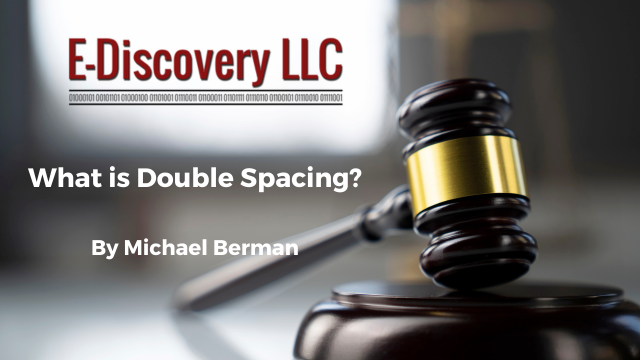
[EDRM Editor’s Note: The opinions and positions are those of Michael Berman.]
A federal court had to define double-spacing. It apparently wasn’t happy about it. See Debra C. Weiss, Ruling in double-spacing kerfuffle, federal judge observes lawyers don’t need ‘more words on a page’ (abajournal.com) (Nov. 29, 2023).
The dispute reminds me of the very funny You Tube video of a deposition called “What is a Photocopier?” In short, that deposition included the following: “When you say photocopy machine, what do you mean?…. There’s different types of photocopy machines…. It’s not a fair question. A photocopy machine can be a machine that uses photostatic technology, that uses xerographic technology, [or] that uses scanning technology. See Pouncing on Little Ambiguities Leads to Discovery Sanctions (citing video and transcript)
Here, the question was what does “double spaced” mean under a Local Rule?
It is three-pages and, it appears to me, it is double-spaced. However, I failed to measure the number of points between the lines. In fact, I’m not sure I know how to do that.
Michael Berman.
First, defendants filed a “motion to require adherence with formatting requirements,” and Ms. Weiss reported that:
The BigLaw firms complained that the plaintiffs’ opposition to a motion for summary judgment wasn’t double-spaced because the lines were 24 points apart, allowing about 27 lines per page instead of the more standard 23 lines. The firms wanted a court order for 28 points between lines, said to be the default spacing used in Microsoft Word, Google Docs and Apple Pages.
Debra C. Weiss, Ruling in double-spacing kerfuffle, federal judge observes lawyers don’t need ‘more words on a page’ (abajournal.com) (Nov. 29, 2023).
Defendants argued that plaintiffs obtained approximately 24 additional pages by the closer spacing. See Motion to Address Brief Formatting Requirements.docx (abovethelaw.com)
Plaintiffs filed an opposition supported by a typography expert. Id. “The plaintiffs also said the BigLaw firms had used 24-point line spacing in some documents filed with the court.” Id.
The ABA article states that “the parties … used more than 60 pages of briefing and exhibits to argue over the meaning of double-spacing.”
The Court was unimpressed and Ms. Weiss reported that the Judge advised the “ law firms involved in a kerfuffle over double-spacing that they should spend less time ‘figuring out how many sometimes-useless words will fit on a page.’”
The ABA posted the unreported decision in Jones v. Varsity Brands, LLC, No. 2:20-cv-02892-SHL-tmp (W.D. Tenn. Nov. 14, 2023).
It is three-pages and, it appears to me, it is double-spaced. However, I failed to measure the number of points between the lines. In fact, I’m not sure I know how to do that.
Amazingly, Judge Lipman cited to a split of authority, writing that “Courts have taken different approaches to this issue.” However, the Judge added: “Reading between the slightly larger spaced lines, it appears that Defendants initially raised this issue in an attempt to extend their time to file a reply in support of their Motion for Summary Judgment.”
The court concluded:
As Defendants point out, the issue of what constitutes a double space has not been raised in this district… The Local Rules themselves do not take a position on the definition of “double spaced.” Therefore, the Court finds that Plaintiffs’ use of twenty-four point spacing does not violate Local Rule 7.1 and DENIES the Motion. However, in so finding, the Court does not take a position on the correct definition of “double spaced. [emphasis added].
Jones v. Varsity Brands, LLC, No. 2:20-cv-02892-SHL-tmp (W.D. Tenn. Nov. 14, 2023).
As Ms. Cassens noted, the court’s closing remark was that the dispute “displays both sides’ tendency toward overkill,” adding:
The Court further notes that the last thing any party needs is more words on a page. The length of an argument is no guarantee of its success, and indeed could result in more confusion, not clarity. Moving forward, the Parties are encouraged to spend their valuable time focusing on the merits of this case, and certainly not figuring out how many sometimes-useless words will fit on a page. [emphasis added].
Id.


